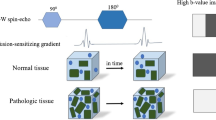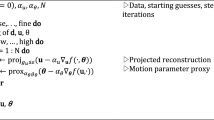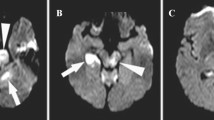Abstract
The precise three-dimensional (3-D) segmentation of cerebral vessels from magnetic resonance angiography (MRA) images is essential for the detection of cerebrovascular diseases (e.g., occlusion, aneurysm). The complex 3-D structure of cerebral vessels and the low contrast of thin vessels in MRA images make precise segmentation difficult. We present a fast, fully automatic segmentation algorithm based on statistical model analysis and improved curve evolution for extracting the 3-D cerebral vessels from a time-of-flight (TOF) MRA dataset. Cerebral vessels and other tissue (brain tissue, CSF, and bone) in TOF MRA dataset are modeled by Gaussian distribution and combination of Rayleigh with several Gaussian distributions separately. The region distribution combined with gradient information is used in edge-strength of curve evolution as one novel mode. This edge-strength function is able to determine the boundary of thin vessels with low contrast around brain tissue accurately and robustly. Moreover, a fast level set method is developed to implement the curve evolution to assure high efficiency of the cerebrovascular segmentation. Quantitative comparisons with 10 sets of manual segmentation results showed that the average volume sensitivity, the average branch sensitivity, and average mean absolute distance error are 93.6%, 95.98%, and 0.333 mm, respectively. By applying the algorithm to 200 clinical datasets from three hospitals, it is demonstrated that the proposed algorithm can provide good quality segmentation capable of extracting a vessel with a one-voxel diameter in less than 2 min. Its accuracy and speed make this novel algorithm more suitable for a clinical computer-aided diagnosis system.






Similar content being viewed by others
References
"The top 10 causes of death," WHO, http://www.who.int/mediacentre/factsheets/fs310/en/index.html, 2002
Arlart IP, Bongartz GM, Marchal G: Magnetic Resonance Angiography. Springer, Tokyo, 1995
Johnson DBS, Prince MR, Chenevert TL: Magnetic resonance angiography: A review. Academic Radiology 5(4):289–305, 1998
Suri JS, Liu KC, Reden L, et al: A review on MR vascular image processing: Skeleton versus nonskeleton approaches: part II. Ieee Transactions on Information Technology in Biomedicine 6(4):338–350, 2002
Wink O, Niessen WJ, Viergever MA: Fast delineation and visualization of vessels in 3-D angiographic images. Ieee Transactions on Medical Imaging 19(4):337–346, 2000
Krissian K, Malandain G, Ayache N, et al: Model-based detection of tubular structures in 3D images. Computer Vision and Image Understanding 80(2):130–171, 2000
Yim PJ, Choyke PL, Summers RM: Gray-scale skeletonization of small vessels in magnetic resonance angiography. Ieee Transactions on Medical Imaging 19(6):568–576, 2000
Frangi AF, Niessen WJ, Hoogeveen RM, et al: Model-based quantitation of 3-D magnetic resonance angiographic images. Ieee Transactions on Medical Imaging 18(10):946–956, 1999
Aylward SR, Bullitt E: Initialization, noise, singularities, and scale in height ridge traversal for tubular object centerline extraction. Ieee Transactions on Medical Imaging 21(2):61–75, 2002
Wilson DL, Noble JA: An adaptive segmentation algorithm for time-of-flight MRA data. Ieee Transactions on Medical Imaging 18(10):938–945, 1999
Chung ACS, Noble JA: “Statistical 3D vessel segmentation using a Rician distribution”, Medical Image Computing and Computer-Assisted Intervention, Miccai'99. Proceedings 1679:82–89, 1999
Chung ACS, Noble JA, Summers P: Fusing speed and phase information for vascular segmentation of phase contrast MR angiograms. Medical Image Analysis 6(2):109–128, 2002
El-Baz A, Farag AA, Gimel'farb G, et al: “Automatic cerebrovascular segmentation by accurate probabilistic modeling of TOF-MRA images,” Medical Image Computing and Computer-Assisted Intervention—Miccai 2005, Pt 1, vol. 3749, pp. 34–42, 2005
El-Baz A, Farag AA, Gimel'farb G, et al: “A new adaptive probabilistic model of blood vessels for segmenting MRA images,” Medical Image Computing and Computer-Assisted Intervention—Miccai 2006, Pt 2, vol. 4191, pp. 799–806, 2006
Hassouna MS, Farag AA, Hushek S, et al: Cerebrovascular segmentation from TOF using stochastic models. Medical Image Analysis 10(1):2–18, 2006
Yu G, Li P, Miao Y, et al: Multiscale active contour model for vessel segmentation. Journal of Medical Engineering & Technology 32(1):1–9, 2008
Farag AA, Hassan H, Falk R, et al: 3D volume segmentation of MRA data sets using level sets—Image processing and display. Academic Radiology 11(4):419–435, 2004
Yan P, Kassim AA: Segmentation of volumetric MRA images by using capillary active contour. Medical Image Analysis 10(3):317–329, 2006
Deschamps T, Schwartz P, Trebotich D et al: “Vessel segmentation and blood flow simulation using Level-Sets and embedded boundary methods,” in Conference of Computer Assisted Radiology and Surgery (CARS), Chicago, USA, pp. 75–80, 2004
Manniesing R, Velthuis BK, van Leeuwen MS, et al: Level set based cerebral vasculature segmentation and diameter quantification in CT angiography. Medical Image Analysis 10(2):200–214, 2006
Masutani Y, Kurihara T, Suzuki M, et al: “Quantitative Vascular Shape Analysis for 3D MR-Angiography Using Mathematical Morphology”, in Conference of Computer Vision. Virtual Reality and Robotics in Medicine, Nice, France, 1995, pp 449–454
Zana F, Klein JC: Segmentation of vessel-like patterns using mathematical morphology and curvature evaluation. Ieee Transactions on Image Processing 10(7):1010–1019, 2001
Flasque N, Desvignes M, Constans JM, et al: Acquisition, segmentation and tracking of the cerebral vascular tree on 3D magnetic resonance angiography images. Medical Image Analysis 5(3):173–183, 2001
Passat N, Ronse C, Baruthio J, et al: Region-growing segmentation of brain vessels: An atlas-based automatic approach. Journal of Magnetic Resonance Imaging 21(6):715–725, 2005
Wells WM, Grimson WEL, Kikinis R, et al: Adaptive segmentation of MRI data. Ieee Transactions on Medical Imaging 15(4):429–442, 1996
Dempster AP, Laird NM, Rubin DB: Maximum Likelihood from Incomplete Data Via Em Algorithm. Journal of the Royal Statistical Society Series B-Methodological 39(1):1–38, 1977
Bilmes JA: A gentle tutorial of the EM algorithm and its application to parameter estimation for Gaussian mixture and hidden Markov models. International Computer Science Institute, Berkeley, California, 1998
Patist JP: “A Fast Implementation of the EM Algorithm for Mixture of Multinomials”, in Conference of Advanced Data Mining and Applications. Xi'An, China, 2006, pp 517–524
Alvarez L, Guichard F, Lions PL, et al: Axioms and Fundamental Equations of Image-Processing. Archive for Rational Mechanics and Analysis 123(3):199–257, 1993
Caselles V, Catte F, Coll T, et al: A Geometric Model for Active Contours in Image-Processing. Numerische Mathematik 66(1):1–31, 1993
Shah J, “Shape recovery from noisy images by curve evolution,” in Conference on Signal and Image Processing, Las Vegas, U.S.A., 1995
Tsai A, Yezzi A, Willsky AS: Curve evolution implementation of the Mumford-Shah functional for image segmentation, denoising, interpolation, and magnification. Ieee Transactions on Image Processing 10(8):1169–1186, 2001
Malladi R, Sethian JA, Vemuri BC: Shape Modeling with Front Propagation—a Level Set Approach. Ieee Transactions on Pattern Analysis and Machine Intelligence 17(2):158–175, 1995
Caselles V, Kimmel R, Sapiro G: Geodesic active contours. International Journal of Computer Vision 22(1):61–79, 1997
Siddiqi K, Lauziere YB, Tannenbaum A, et al: Area and length minimizing flows for shape segmentation. Ieee Transactions on Image Processing 7(3):433–443, 1998
Chakraborty A, Staib LH, Duncan JS: Deformable boundary finding in medical images by integrating gradient and region information. Ieee Transactions on Medical Imaging 15(6):859–870, 1996
Zhu SC, Yuille A: Region competition: Unifying snakes, region growing, and Bayes/MDL for multiband image segmentation. Ieee Transactions on Pattern Analysis and Machine Intelligence 18(9):884–900, 1996
Jones TN, Metaxas DN: “Image segmentation based on the integration of pixel affinity and deformable models”, in Conference on Computer Vision and Pattern Recognition (CVPR). Santa Barbara, USA, 1998, pp 330–337
Chesnaud C, Refregier P, Boulet V: Statistical region snake-based segmentation adapted to different physical noise models. Ieee Transactions on Pattern Analysis and Machine Intelligence 21(11):1145–1157, 1999
Mumford D, Shah J: Optimal Approximations by Piecewise Smooth Functions and Associated Variational-Problems. Communications on Pure and Applied Mathematics 42(5):577–685, 1989
Baillard C, Barillot C, Bouthemy P: Robust adaptive segmentation of 3D medical images with level sets, INRIA Technical Report, 2000
Descoteauxa M, Collinsb DL, Siddiqi K: A geometric flow for segmenting vasculature in proton-density weighted MRI. Medical Image Analysis 12(4):497–513, 2008
Frangi AF, Niessen WJ, Vincken KL et al: “Multiscale Vessel Enhancement Filtering ” in Conference on Medical Image Computing and Computer-Assisted Interventation (MICCAI), Cambridge, U.S.A., 1998, pp. 130–137
Cai WL, Dachille F, Harris GJ, et al: “Vesselness propagation: a fast interactive vessel segmentation method,” in Processings of the SPIE. Medical Imaging, San Diego, U.S.A, 2006, pp 1343–1351
Ye DH, Kwon DJ, Yun ID, et al: “Fast multiscale vessel enhancement filtering,” in Processings of the SPIE, Medical Imaging, San Diego, U.S.A, pp. 691423–691428, 2008
Sethian JA: Curvature and the Evolution of Fronts. Communications in Mathematical Physics 101(4):487–499, 1985
Sethian JA: Level Set Methods and Fast Marching Methods: Evolving Interfaces in Computational Geometry, Fluid Mechanics, Computer Vision, and Materials Science. Cambridge University Press, New York, U.S.A, 1999
Osher S, Fedkiw RP: Level set methods: An overview and some recent results. Journal of Computational Physics 169(2):463–502, 2001
Lie J, Lysaker M, Tai XC: A binary level set model and some applications to Mumford-Shah image segmentation. Ieee Transactions on Image Processing 15(5):1171–1181, 2006
Yang Y: “Image segmentation and shape analysis of blood vessels with applications to coronary atherosclerosis,” School of Biomedical Engineering, Georgia Institute of Technology, 2007
Yushkevich P, e. al: "itk-SNAP software," http://www.itksnap.org/pmwiki/pmwiki.php
Uchiyama Y, Gao X, Hara T, et al: “Computerized detection of unruptured aneurysms in MRA images: Reduction of false positives using anatomical location feature,” in SPIE Medical Imaging: Computer-aided diagnosis, San Diego, U.S., 2008, pp. 69151Q-1–69151Q-8
Acknowledgment
This work was supported in part by a grant for the “Knowledge Cluster Creation Project” from the Ministry of Education, Culture, Sports, Science and Technology, Japan.
Author information
Authors and Affiliations
Corresponding author
Appendix
Appendix
Reasonable initialization of parameters will guarantee iterations of EM to consistently converge to a local minimum that proves empirically value. An automatic method for parameter initialization was developed. This initialization is based on the character of a normalized intensity histogram. The important procedure of the initialization is to estimate the parameters of the probability distributions corresponding to two distinct peaks with a long tail over a high-intensity region.
Let h(I) be the normalized intensity frequency corresponding to intensity I. The superscript 0 of the parameters presents initial value.
-
(1)
Peak1—Rayleigh distribution
σ 0 is parameter of Rayleigh distribution. P 0 is the prior probability of Rayleigh distribution.
-
(2)
Peak2—Gaussian distribution
\( \mu_{n - 1}^0 = {I_{{\rm{peak}}2}} \), \( \sigma_{n - 1}^0 \) is calculated using the maximum likelihood estimation (MLE) for Gaussian distribution in the region \( \left[ {{I_{{\rm{peak}}2}} - 20,{I_{{\rm{peak}}2}} + 20} \right]\,{\hbox{of}}\,h(I),p_{n - 1}^0 = \frac{{h\left( {\sigma_{n - 1}^0} \right)}}{{{p_G}\left( {\sigma_{n - 1}^0|\left( {\sigma_{n - 1}^0,p_{n - 1}^0} \right)} \right)}}. \)
μ n−1 and σ n−1 are parameters of the Gaussian distribution. P n−1 is the prior probability of the Gaussian distribution.
-
(3)
Long tail—Gaussian distribution
Find intensity I vessel that satisfies \( \frac{{\sum\limits_{l = {I_{\rm{vessel}}}}^{{I_{\max }}} {h\left( {{I_l}} \right)} }}{{\sum\limits_{l = 1}^{{I_{\max }}} {h\left( {{I_l}} \right)} }} = 0.03 \). That is, we rudely estimate the threshold of vessels from the last 3% of the high-intensity data of the observed histogram.
\( \mu_n^0 = \frac{{{I_{\max }} - {I_{\rm{vessel}}}}}{2} \). \( \sigma_n^0 \) is calculated using the MLE 31 method for Gaussian distribution based on parameters \( \mu_{13}^0 \), I vessel and I max. \( p_n^0 = 0.03 \).
μ n1 and σ n are parameters of the Gaussian distribution relative to cerebral vessel. P n is the prior probability of the Gaussian distribution.
The other Gaussian distributions equidistantly locate in the region \( \left[ {{I_{{\rm{peak}}1}} + 12,{I_{{\rm{peak}}2}} - 12} \right]. \)
Rights and permissions
About this article
Cite this article
Gao, X., Uchiyama, Y., Zhou, X. et al. A Fast and Fully Automatic Method for Cerebrovascular Segmentation on Time-of-Flight (TOF) MRA Image. J Digit Imaging 24, 609–625 (2011). https://doi.org/10.1007/s10278-010-9326-1
Published:
Issue Date:
DOI: https://doi.org/10.1007/s10278-010-9326-1




